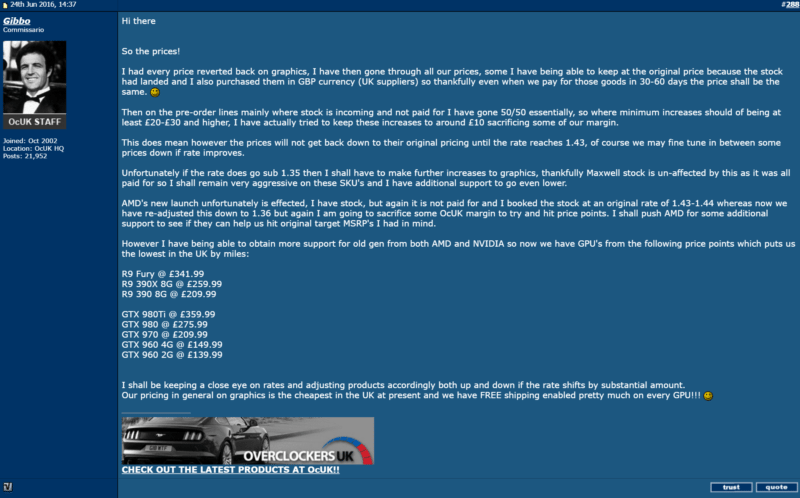AMD Radeon RX 480 Graphics Card Review
John Williamson / 8 years ago
Final Thoughts
Price
A large aspect of the RX 480’s appeal is its ridiculously cheap $199.99 price point and ability to offer a “premium VR experience”. Of course, import duty, tax and other factors can impact on the price in non-US regions and it’s very rare to see a simple currency conversion. Unfortunately, the RX 480’s launch price in the UK has been increased according to Andrew “Gibbo” Gibson from Overclockers UK:

This is due to the devaluation of Sterling from 1.43-1.44 to around 1.32. While AMD has provided me with the UK RRP, I’m interested to see if retailers charge more due to the uncertain financial market or it’s already been adjusted. Putting the Brexit vote aside, the RX 480 4GB version should retail for £180.00 while the 8GB has a recommended price of £215. This is marvellous value-for-money because the 4GB model is similarly priced to the GTX 960 and destroys it. Heck, I didn’t include the GTX 960 in the benchmarks given the poor performance at advanced presets. Also, the 8GB version is great value and priced near the GTX 970. While it falls behind in some DirectX 11 games, the lead is substantial when opting for the latest API.
Overview
Since the RX 480 was first announced, there’s been much speculation regarding its performance and some users idealistically hoped it would offer better frame-rates than the GTX 1070 and GTX 980Ti. Even more absurd, a few enthusiasts claimed the RX 480 would go toe-to-toe with the GTX 1080 despite being over £400 cheaper. When analysing this particular graphics card, it’s essential to have realistic expectations and acknowledge that Polaris 10 was always designed for the mass market and affordability; it’s a shame that some users will feel slightly disappointed because they made incorrect assumptions.
Now that I’ve clarified this situation, let’s move onto the actual performance numbers. The RX 480 slots in between the GTX 970 and GTX 980 depending on which API is being used. Throughout DirectX 12 games like Ashes of the Singularity, the graphics card performed brilliantly and it’s shocking how fluid the frame-rate can be while running extreme presets. This even applies when you select a 2560×1440 display and the minimum frame-rate drop off is relatively small. On another note, the RX 480 remains really close to the R9 390 despite using very early press drivers. Therefore, I expect the GPU to be much better placed in the coming months and it should match the R9 390 once drivers mature.
The graphics card isn’t just intended to work alongside a 1080p monitor and it’s able to maintain very solid frame-rates at higher resolutions. The average and minimum figures remain fairly close which suggests a consistent experience and you’re unlikely to encounter major hitching. Reducing the graphical presets slightly should allow you to enjoy 60 frames-per-second gaming on a more detailed screen. Of course, 1440p monitors aren’t that cheap yet and the target market remains gamers with a 1080p panel.
It’s not all perfect though because the blower style cooler can become fairly loud under extreme loud and struggles to keep the core under 90C. Thankfully, custom cooled versions are coming relatively soon and they should address this problem. On a similar note, the hefty thermal output means it’s quite challenging to achieve a substantial overclock. While I did attain a decent 1355MHz boost clock, it’s not the 1,4GHz and beyond many enthusiasts predicted. Saying that, I do think it’s possible with better cooling hardware and additional power connectors.
Aesthetically-speaking, the RX 480 is beautiful and looks much more expensive than its price point suggests. More specifically, the striking Radeon logo, soft cover plate and attractive colour scheme coalesce in a wonderful manner. Even though I’m not that keen on blower design graphics cards, the construction is very solid and utilises a reliable power design. On a sample I received, there wasn’t any coil whine or evidence of lacklustre workmanship.
In addition to the RX 480’s stunning price to performance ratio, there’s been a raft of architectural improvements and AMD has assured users that they’re working on a more frequent driver update schedule. Polaris 10’s exceptional performance per watt, support for hardware-level asynchronous compute, lossless delta colour compression, HDR, enhanced geometry engines and shader efficiency to name a few demonstrates how much work has gone into AMD’s next line-up.
To summarise, the RX 480 is arguably the best budget graphics card ever devised and revolutionises the kind of performance one can expect on a tight budget. The GPU is able to provide a superb VR experience and it could contribute to making VR equipment much cheaper in the next year or so. If you’re moving into the PC gaming stratosphere for the first time or want to make a safe investment, nothing will currently match the RX 480. When you consider the price and performance levels of previous budget hardware, AMD should be commended for adopting such an aggressive pricing strategy.
Pros
- Astonishing frame-rates in DirectX 12 games
- Beautiful aesthetic design
- Excellent construction
- Extremely low power consumption
- High-quality electronics
- Improved hardware-level asynchronous compute
- Magnificent entry card for VR
- Suitable for 1440p gaming
- Supports FreeSync, LiquidVR and other innovative technologies
- Unbelievable value
- Wonderful 1080p results
Cons
- Limited overclocking room
- High thermals
- Stock cooler isn’t quiet under load
“The AMD RX 480 is a pro-consumer move towards affordable yet powerful GPUs which brings VR to the masses. It’s able to output superb frame-rates even when using a 1440p monitor and should act as a catalyst to make PC gaming more inclusive to a wider audience.”

AMD Radeon RX 480 Graphics Card Review
Thank you AMD for providing us with this review sample.



















